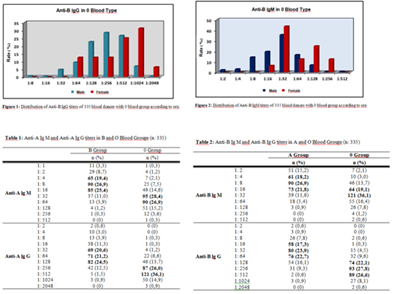
Contributions
Abstract: PB2237
Type: Publication Only
Background
Isohemaglutinins that develop against ABO blood group antigens are very important in transfusion and transplantation medicine. Today, 30-40% of allogeneic stem cell transplantations are ABO incompatible transplantation, 20-25% of which are major, 20-25% are minor and remaining bi-directionally incompatible transfusion. Our study; based on the knowledge that isohemagglutinins play an important role in blood transfusion policies in patients undergoing ABO incompatible hematopoietic stem cell transplantation(HSCT) has been shaped by the assumption that each healthy blood bank donor may be potential transfusion donors for ABO incompatible HSCT transplant recipients
Aims
In this study, we investigated the isohemagglutinin titer values of the individuals with A, B and O blood groups; the distribution of the isohemagglutinin titers according to the decades and gender. Also we examined the posibility of determining the isohemagglutinin cut off value in Turkish society.
Methods
One thousand five voluntary blood donors (48 female, 957 male), randomly chosen from the donors, providing the criteria to be a standard blood donor in Blood Center Department, Istanbul Faculty of Medicine were studied. This study was approved by the Ethics Committee of Istanbul Medical Faculty. In the donor population group; blood group A (%40) was the most common and blood group AB was the rarest blood group. Accoording to the Rh D phenotypes; 85 % of the population was Rh D positive and 15 % of the population was Rh D negative.The frequency of our blood group was determined similar with other European countries. The most common age range of one thousand five voluntary blood donors, including the same rate individuals with blood group A, B and O, was the age range between 26 and 35 years. Forward and reverse blood group determination were performed to these donors and also we identified the Anti-B Ig M and Ig G isohemagglutinin titer values for blood group A; Anti-A Ig M and Ig G titer values for blood group B; eventually both Anti-A Ig M /Ig G and Anti-B Ig M/ Ig G izohemaglutinin titer values for blood group O by using column agglutination methods. Statistical analysis was performed with NCSS (Number Cruncher Statistical System) 2007 (Kaysville, Utah, USA).
Results
While the titer value of Anti-A Ig M isohemagglutinin was 1:128 for female individuals with blood group B; the titer values of both Anti-B Ig M (1:128 and 1:256), Anti-B Ig G (1:1024) and Anti-A Ig M (1:256) isohemagglutinins were statistically significiance in female individuals rather than male ones. The levels of isohemagglutinin in the blood groups A, B and 0 are shown in Tables 1 and 2. There was no statistical difference in anti-B IgG and IgM titers in blood group A, anti-A IgG and IgM titers in blood group B and anti-A IgG and IgM titers in blood group O between males and females(p>0.05). However Anti-B IgG and IgM antibody titers were higher in females than males in donors with blood group O respectively p=0,017 (p<0,05) and p= 0.001 (p<0,01) (Figure 1 and 2).

Conclusion
Female individuals of blood bank donors participated in our study have higher isohemagglutinin titer values rather then male individuals. Recurrent blood group incompatibility in pregnancy, invasive diagnostic and therapeutical approaches for risk analysis in fetal examination during pregnancy, perinatal complications causing fetomaternal hemorrhage after pregnancy or during birth and lastly autoimmun diseases cause the enchancement of isohemagglutinin titer values in female individuals. Regarding the gender differences; nutrition, vaccination and recurrent blood transfusion history of blood bank donors alsa effect and change the isohemagglutinin titers of individuals. Population spesific isohemagglutinin titer values play a key role in blood donation policy of patients undergoing hematopoietic stem cell transplantation. Consequently; we predict that Turkish community-spesific isohemagglutinin cut off titer values can be identified and we will hope our knowledge on this issue in the future with the increase of research is going to increase further.
Session topic: 30. Transfusion medicine
Keyword(s): Allogeneic stem cell transplant, ABO blood group
Abstract: PB2237
Type: Publication Only
Background
Isohemaglutinins that develop against ABO blood group antigens are very important in transfusion and transplantation medicine. Today, 30-40% of allogeneic stem cell transplantations are ABO incompatible transplantation, 20-25% of which are major, 20-25% are minor and remaining bi-directionally incompatible transfusion. Our study; based on the knowledge that isohemagglutinins play an important role in blood transfusion policies in patients undergoing ABO incompatible hematopoietic stem cell transplantation(HSCT) has been shaped by the assumption that each healthy blood bank donor may be potential transfusion donors for ABO incompatible HSCT transplant recipients
Aims
In this study, we investigated the isohemagglutinin titer values of the individuals with A, B and O blood groups; the distribution of the isohemagglutinin titers according to the decades and gender. Also we examined the posibility of determining the isohemagglutinin cut off value in Turkish society.
Methods
One thousand five voluntary blood donors (48 female, 957 male), randomly chosen from the donors, providing the criteria to be a standard blood donor in Blood Center Department, Istanbul Faculty of Medicine were studied. This study was approved by the Ethics Committee of Istanbul Medical Faculty. In the donor population group; blood group A (%40) was the most common and blood group AB was the rarest blood group. Accoording to the Rh D phenotypes; 85 % of the population was Rh D positive and 15 % of the population was Rh D negative.The frequency of our blood group was determined similar with other European countries. The most common age range of one thousand five voluntary blood donors, including the same rate individuals with blood group A, B and O, was the age range between 26 and 35 years. Forward and reverse blood group determination were performed to these donors and also we identified the Anti-B Ig M and Ig G isohemagglutinin titer values for blood group A; Anti-A Ig M and Ig G titer values for blood group B; eventually both Anti-A Ig M /Ig G and Anti-B Ig M/ Ig G izohemaglutinin titer values for blood group O by using column agglutination methods. Statistical analysis was performed with NCSS (Number Cruncher Statistical System) 2007 (Kaysville, Utah, USA).
Results
While the titer value of Anti-A Ig M isohemagglutinin was 1:128 for female individuals with blood group B; the titer values of both Anti-B Ig M (1:128 and 1:256), Anti-B Ig G (1:1024) and Anti-A Ig M (1:256) isohemagglutinins were statistically significiance in female individuals rather than male ones. The levels of isohemagglutinin in the blood groups A, B and 0 are shown in Tables 1 and 2. There was no statistical difference in anti-B IgG and IgM titers in blood group A, anti-A IgG and IgM titers in blood group B and anti-A IgG and IgM titers in blood group O between males and females(p>0.05). However Anti-B IgG and IgM antibody titers were higher in females than males in donors with blood group O respectively p=0,017 (p<0,05) and p= 0.001 (p<0,01) (Figure 1 and 2).

Conclusion
Female individuals of blood bank donors participated in our study have higher isohemagglutinin titer values rather then male individuals. Recurrent blood group incompatibility in pregnancy, invasive diagnostic and therapeutical approaches for risk analysis in fetal examination during pregnancy, perinatal complications causing fetomaternal hemorrhage after pregnancy or during birth and lastly autoimmun diseases cause the enchancement of isohemagglutinin titer values in female individuals. Regarding the gender differences; nutrition, vaccination and recurrent blood transfusion history of blood bank donors alsa effect and change the isohemagglutinin titers of individuals. Population spesific isohemagglutinin titer values play a key role in blood donation policy of patients undergoing hematopoietic stem cell transplantation. Consequently; we predict that Turkish community-spesific isohemagglutinin cut off titer values can be identified and we will hope our knowledge on this issue in the future with the increase of research is going to increase further.
Session topic: 30. Transfusion medicine
Keyword(s): Allogeneic stem cell transplant, ABO blood group


